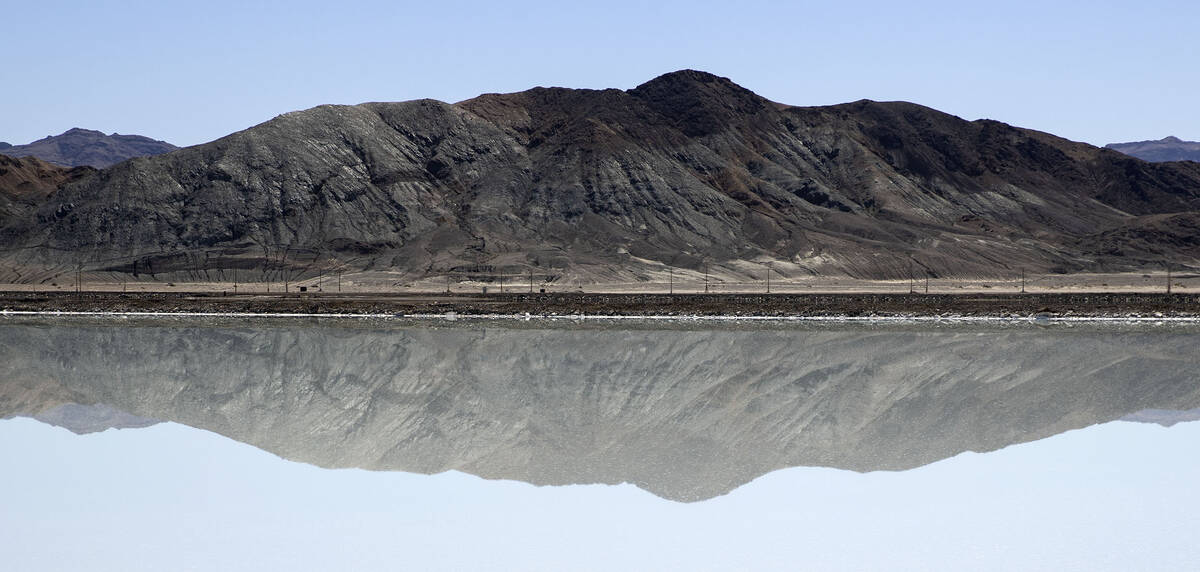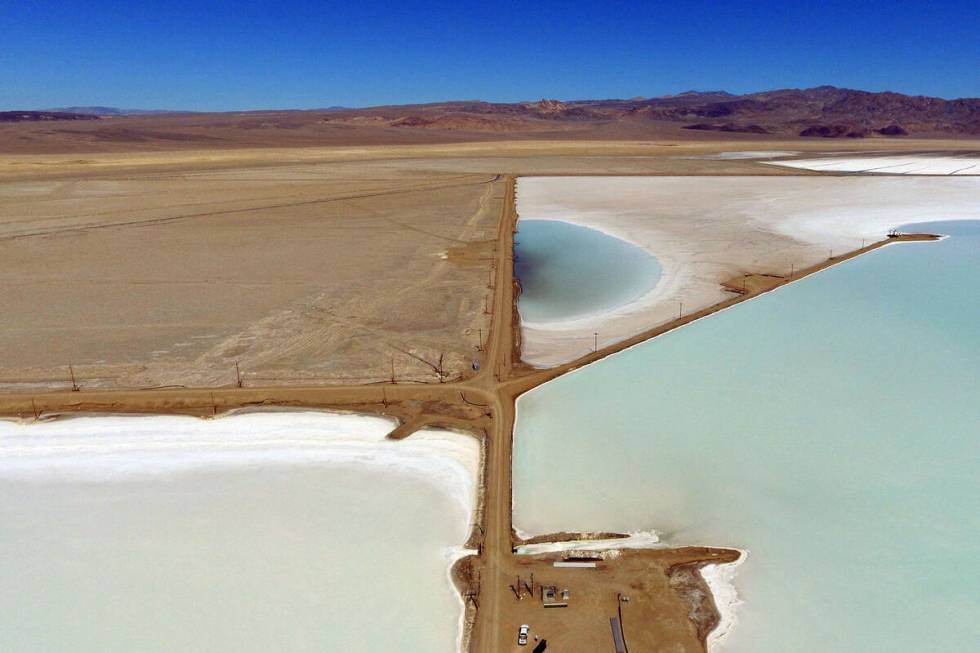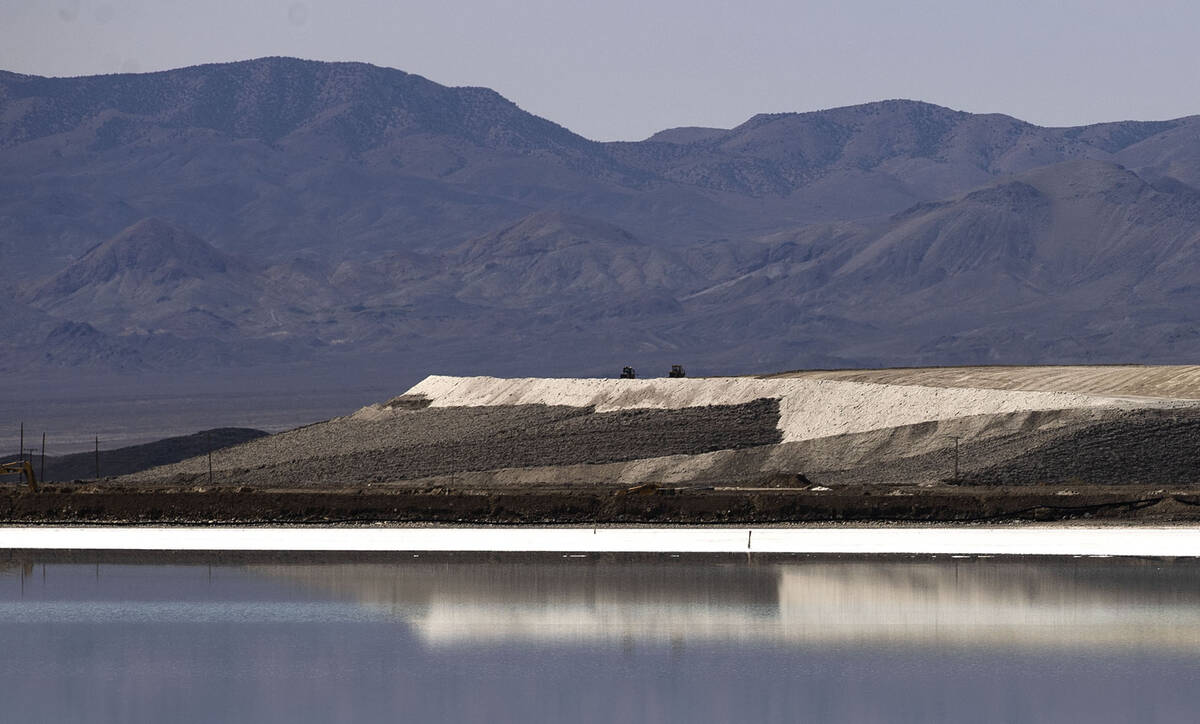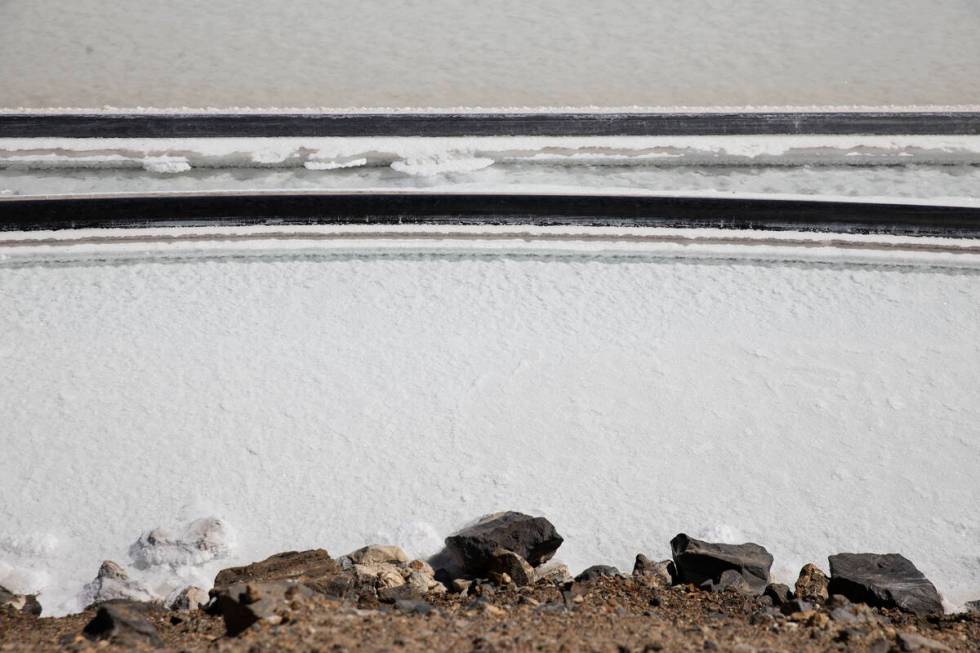With global demand for cleaner energy to power cars, smart homes and phones predicted to rise forty-fold through 2040, a different silvery metal stands to replace the Comstock Lode of yore as the namesake product of the Silver State.
That high-energy metal, lithium, is so light it floats on water before fizzing away in a chemical reaction. Nevada’s economic future is hard-wired to it and the industries its production supports.
The state already occupies a prominent, if not quite dominant place in lithium’s past and present as a potent clean energy source. The leading method for obtaining it – extracting it from underground brines – was perfected in Nevada and is now used worldwide.
At Silver Peak in Esmeralda County, roughly halfway between Las Vegas and Reno, a lithium facility has operated since the mid-1960s and is still the only lithium producer in the U.S. Lithium is recovered there by evaporating the brine in large ponds in a process that takes 18-24 months.
Now Nevada, by the same accident of geography and geology that makes it a mining mecca for all kinds of metals and minerals, is poised to see lithium production skyrocket, fueling its economic growth along with its ambitions to become for energy transmission “what Wall Street is to finance, or what Silicon Valley is to technology,” as Gov. Steve Sisolak said in his 2021 state of the state address in January.
A deposit at Thacker Pass in Humboldt County near the Oregon border, where mining production is slated to start next year, is thought to be the largest lithium deposit in North America and potentially the world. Mining the clays of a prehistoric volcanic caldera there could produce more than 3 million tons of lithium carbonate, a primary compound in battery production, with operations continuing for nearly half a century.
That potential windfall is not without its detractors, mostly environmentalists and some residents, including a subset of the area’s Native American population. Opponents charge that the project, and operations like it, will adversely affect area flora and fauna, not to mention groundwater and other natural resources. Legal challenges to stop or slow Thacker Pass on those grounds have thus far been turned away, with a federal judge to date finding no fault with the approval and permitting process.
A broader issue is the paradox inherent with some efforts to harness cleaner energy to fight galloping climate change: What regional resource – say, a rare plant species, as in the case of another planned lithium project in the Nevada desert – could be sacrificed in the name of helping the planet globally?
Add to that a corollary: With cleaner energy resources such as lithium critical to meeting carbon reduction goals, is it better from a global perspective to recover them in regions of the world where stricter regulations and oversight govern the process?
“You can’t decide where you want to build the mine. The mine is built where the resources are, and sometimes that’s a hard concept for people to understand,” said Mike Visher, administrator of the state Division of Minerals, in recent interview.
“All of the metals that are needed for your phone come out of the ground,” he said. “So where do you want them to come from? From a place where it’s highly regulated, or from a third world country where nobody’s paying attention? And what’s more environmentally responsible for the world?”

Present and future mining
At Silver Peak, mineral salts precipitate out in stages across some 4,000 acres of evaporation ponds from subsurface brine that is five to ten times saltier than ocean water. The operation employs fewer than 100 people and is the only one of its kind in the U.S.
Not far away to the west, at Rhyolite Ridge, a lithium-boron mine could start production in 2024. Australia-based operator ioneer recently partnered on the project with a South African mining concern that paid $490 million to buy into the venture – a telling indicator of where the lithium market stands.
American Lithium Corp., an exploration company, continues to sample and drill at its 7,500-acre TLC Lithium Project site near Tonopah. The site is northwest of Silver Peak and sits on the same geologic formation. Also nearby, in Clayton Valley, a pilot project led by mining services giant Schlumberger and battery maker Panasonic is developing a new way to extract lithium from subsurface brine, injecting it back into the ground without using additional water.
Operations at Silver Peak, which is owned by North Carolina-based Albemarle Corp., one of the largest lithium producers worldwide, are dwarfed by production in places like Chile, Australia and China; Silver Peak now produces about 1 percent of worldwide output – less than one-fifth of what the Tesla/Panasonic battery Gigafactory outside Reno uses in a year. Albemarle announced plans in January to double production there over the next five years.
Silver Peak is a “fairly small resource” that has operated largely “under the radar screen” – until interest in electric vehicles and other uses for lithium took off, says Eric Norris, president of Albemarle’s lithium business. Production there ultimately is constrained by the amount of brine that can be extracted annually, but overall, the potential for lithium related businesses is “extraordinarily exciting.”
Besides limited production in the U.S., there is currently no refining capacity here to supply the materials needed by battery megafactories. There are now three in the U.S. including the Tesla/Panasonic plant, with five more anticipated by 2024. What Silver Peak produces is shipped to Asia to be made into cathodes for batteries.
“So even if we were to have a significant expansion of capacity today, chances are we’ll still be doing a lot of exporting that back to Asia before that product came back here to the U.S.,” Norris said.
That inevitably will change as traditional automakers follow Tesla into the EV market. Ford last week announced it would spend more than $11 billion over the next four years to build four EV factories.
“I think we’ve gone beyond the tipping point,” Norris said. “That’s going to drive that supply chain into the U.S. And so that’s one reason we’re expanding Silver Peak.”
 Water is pumped into an evaporation pond at Albemarle's lithium mine in Silver Peak, Nev., on Tuesday, Sept. 21, 2021.
Water is pumped into an evaporation pond at Albemarle's lithium mine in Silver Peak, Nev., on Tuesday, Sept. 21, 2021.  Water is pumped into an evaporation pond at Albemarle's lithium mine in Silver Peak, Nev., on Tuesday, Sept. 21, 2021.
Water is pumped into an evaporation pond at Albemarle's lithium mine in Silver Peak, Nev., on Tuesday, Sept. 21, 2021.  Signs of the nearby cities and towns are posted near Albemarle's lithium mine in Silver Peak, Nev., on Tuesday, Sept. 21, 2021.
Signs of the nearby cities and towns are posted near Albemarle's lithium mine in Silver Peak, Nev., on Tuesday, Sept. 21, 2021.Nevada production small, about to boom
Overall, the value of Nevada’s lithium production is minuscule. In 2019, it amounted to less than half a percent of all mining production in the state – 7.9 million pounds valued at $36 million, against more than $8 billion for all metals and minerals. But that, again, represented the entire U.S. lithium output.
While not rare, lithium was labeled “critical” to the nation’s economic and national security in a June White House report on resilient supply chains. With about 4 percent of known global lithium reserves, the U.S. ranks fifth in the world behind Chile – far and away the largest source – followed Australia, Argentina and China.
The U.S. is also well behind in global production. According to data compiled in BP’s annual Statistical Review of World Energy, it tied at seventh with Portugal in 2020, at just under 1 percent. Australia produced 40 percent, followed by Chile at nearly 21 percent, China at 14 percent, Argentina at 6 percent, and Brazil and Zimbabwe, at 1.9 percent and 1.2 percent, respectively.
Those U.S. production numbers will change, and Nevada stands both to drive that change and benefit from it. Sisolak, in his 2021 state of the state address, anchored his call to make Nevada a national hub for electrical grid storage and transmission noting that the state “is home to the most accessible lithium reserves in North America.”
Nevada’s ambitions, not only as a lithium producer but also as a hub for power generation, storage and transmission for the Western United States, are built into its long-term energy aspirations, which include conservation as well.
“The potential for us to become a worldwide leader in lithium production is significant,” Sen. Pat Spearman, D-North Las Vegas, told a legislative committee last spring regarding her resolution seeking a legislative study on developing production of lithium and other clean-energy minerals.
Demand for electric cars, batteries and recycling technology and electronics offer “key opportunities for economic development, providing much-needed high paying jobs and increased tax revenue,” she added, not to mention helping “decrease carbon emissions, improve air quality, and protect the respiratory health of Nevadans, particularly those in our communities of color or who are economically disadvantaged.” The resolution passed the Senate but did not get a vote in the Assembly.


Lithium brings jobs, related businesses
The Thacker Pass project is a poster child for the state’s claims and ambitions, standing as both the largest and highest-grade known sedimentary deposit of lithium in the U.S. It lies near the surface in soft material that it will be mined in stages down to a maximum depth of 400 feet with minimal blasting.
The developer, Lithium Americas, plans a two-phase project that initially will produce 33,000 tons of battery-grade lithium carbonate annually for the first four years, doubling that output thereafter. The site is located on 18,000 acres of public lands, of which about one-third of which would be disturbed. The open pit would be backfilled in stages during the life of mine.
Projections include more than 800 construction jobs at the outset and 300 permanent jobs during its operation, along with jobs for suppliers of products and services and tax payments of $6.7 billion to governments, depending on lithium pricing. The U.S. Bureau of Land Management approved the project in January.
Beyond production, Lithium Americas’ president and CEO Jonathan Evans says the U.S. needs to look at expanding capacity through the entire supply chain to avoid losing out on downstream demand for the finished products. The U.S. will never be self-sufficient in lithium, but failing to build out the industries that rely on it is a missed opportunity that also threatens supply chain security, he said.
“I remember when consumer electronics sort of left (the U.S.) and you didn’t even notice it,” Evans says. “This you’ll notice, because there’s so much investment going into automotive companies, so much commitment, that it would be a shame for these types of jobs to go away.”
Nevada, he said, “is in a unique position, where you can have the complete ecosystem in the state,” from raw materials to processing to manufacturing. “I can’t think of any other state where that’s even a reality at this point, and you’ve got some great cornerstone businesses there that you can build on.”


Environmental concerns
None of that mollifies project opponents, which include environmental organizations, a local rancher and certain Native American tribes, who have sued to stop the project. They cite impacts on wildlife – among them, a golden eagle nesting pair and habitat for the sage grouse – along with depleting groundwater sources and disturbing potential historical and culturally significant tribal sites. There are also those who oppose all mining in a wilderness area on principle.
A federal judge in Reno so far has denied requests for injunctions, finding no evidence that the project permitting process was wrongly fast-tracked, with mitigation measures in place for contingencies. A ruling on the merits of the case is expected by early next year.
Lithium Americas says its efforts to mitigate and minimize impacts includes a commitment to make the project carbon neutral. It plans to recycle the sulfuric acid it will manufacture on site to leach lithium from the clay, use heat created in that process to generate power, tap into geothermal sources for its remaining power needs, and has committed permanently to stay out of the adjacent Montana mountains – a prime sage grouse habitat. It also has engineered the project to minimize light pollution and traffic impacts.
The company purchased water rights from two ranches in nearby Orovada and says it will draw the same amount of water over the course of a full year that currently gets used during growing season only. It has worked with area stakeholders, including the Fort McDermitt Paiute and Shoshone Tribe, and cites far more local support than opposition.
“I think the voices of dissent are pretty small, but they’re loud,” Evans said. “All those issues, whether it’s the wildlife, water, air emissions have extensive work that’s been done prior to the formal permitting process.”
“People always talk about we’re fast tracking things in the U.S. Far from it,” he added. “Things take longer in the U.S. to develop than probably anywhere else in the world based on the very extensive permitting regimes that we have to go through, public comment periods and so forth.”
Norris, from Albemarle, makes a similar point. The briny water Silver Peak relies on is nowhere near potable. Drawn from a terminal basin, there’s a limit to how much can be sustainably drawn and replenished over time. There is also the question of marketing.
“When you think about this industry, what we are doing is not only trying to be responsible in the environment, which is critically important, but beyond that, it’s what our customers want of us,” Norris said. Companies building electric vehicles, for example, “want a product that we certify as being sustainable, because they’re marketing a car that’s supposed to be sustainable. So they’ve got to make sure that their supply base does the same.”
Evaporating brines with sunlight – which also recovers additional mineral salts – uses little energy. For the Silver Peak plant, “when we add it all up, both the cost profile and the sustainability profile, you can’t beat evaporation,” he said.

Endangered flower
Elsewhere, near the Rhyolite Ridge project, a species of buckwheat wildflower that grows nowhere else in the world has been recommended for endangered species protection in a yearlong review that will conclude in May. The Center for Biological Diversity sees the plant threatened by ioneer’s lithium project. A year ago, conservationists alleged that “someone” had destroyed more than half of the plants at the site; an investigation by the U.S. Fish and Wildlife Service determined that the plants had been eaten by rodents.
Conservationists say the flower will be wiped out by the proposed mine; ioneer counters the bigger threat to the flower is climate change itself, and maintains that the rare flower and mine can co-exist with conservation efforts and compaby-supported research on finding new environments for the plant.
There lies the quandary, as state geologist James Faulds of the University of Nevada, Reno notes. Most people want to “decarbonize our energy grid as much as possible. And that results in some other impacts.” Protecting a rare plant species, for example, “that’s important. We should worry about that,” he said. “But it’s not like we can mine lithium and not have something impacted somewhere.”
What’s more, by discouraging or prohibiting mining here, potentially shifting it to developing nations with more lax regulation, “Then we’re really just saying, ‘Well, no, do this in your backyard, right? Because our backyard is more precious.’”
“We have a lot of resources that can help transition our energy away from carbon based fossil fuels,” he said, at the same time diversifying local and state economies. “Let’s try to promote this, take advantage of it, and try to mitigate as the impacts as much as possible. There will be impacts, but it’ll be a very, very small percentage of the land.”
Contact Capital Bureau reporter Bill Dentzer at bdentzer@reviewjournal.com. Follow @DentzerNews on Twitter.














